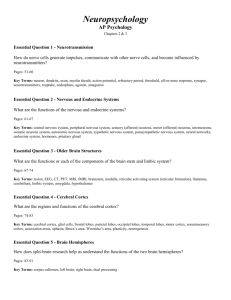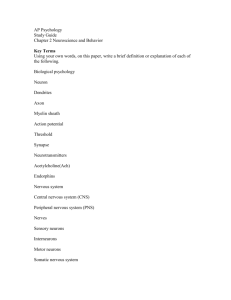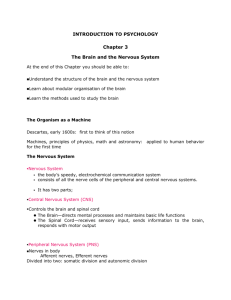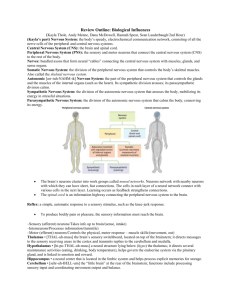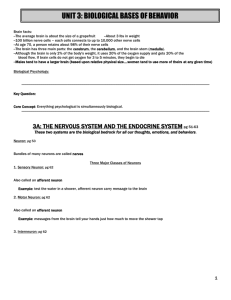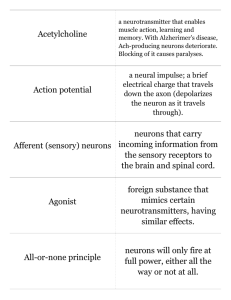Print › psych chapter 2 | Quizlet | Quizlet
advertisement
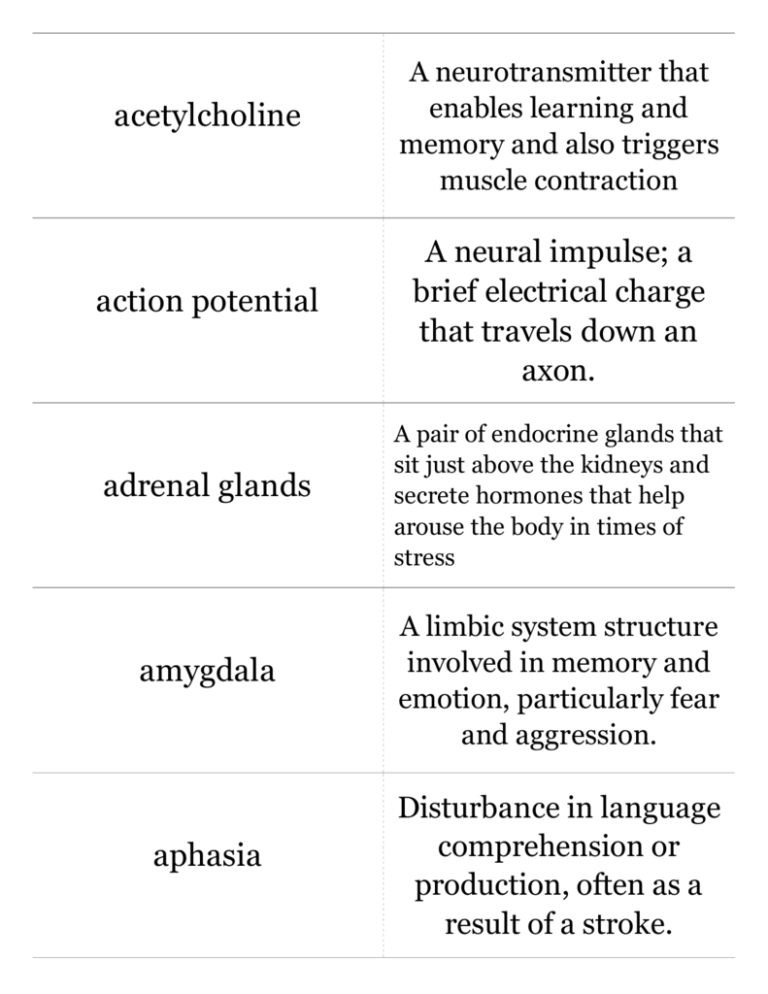
acetylcholine A neurotransmitter that enables learning and memory and also triggers muscle contraction action potential A neural impulse; a brief electrical charge that travels down an axon. adrenal glands A pair of endocrine glands that sit just above the kidneys and secrete hormones that help arouse the body in times of stress amygdala A limbic system structure involved in memory and emotion, particularly fear and aggression. aphasia Disturbance in language comprehension or production, often as a result of a stroke. association areas An area of the cerebral cortex that functions in linking and coordinating the sensory and motor areas. autonomic nervous system A subdivision of the peripheral nervous system. Controls involuntary activity of visceral muscles and internal organs and glands. axon A long, thin fiber that transmits signals away from the neuron cell body to other neurons, or to muscles or glands. biological psychology A branch of psychology concerned with the links between biology and behavior brainstem Lower portion of the brain that connects the cerebrum with the spinal cord. Broca's area Controls language expressionan area, usually in the left frontal lobe, that directs the muscle movements involved in speech. Cell body Processes nutrients and provides energy for the neuron to function; contains the cell's nucleus; also called the soma. central nervous system Brain and spinal cord cerebellum A large structure of the hindbrain that controls fine motor skills. cerebral cortex Outer layer of the brain, thinking, organizing, and creative center. corpus callosum A thick band of axons that connects the two cerebral hemispheres and acts as a communication link between them. CT scan A computer-enhanced X-ray image of the brain or body Dendrites A neuron's bushy, branching extensions that receive messages and conduct impulses toward the cell body. a graphical record of electroencephalogram electrical activity of the brain endocrine system Glands secrete hormones that regulate growth and the release of calcium endorphines "morphine within"; natural, opiatelike neurotransmitters linked to pain control and to pleasure frontal lobes Cortical regions at the front of the brain that are especially involved in movement and in thinking. glial cells Cells in the nervous system that support, nourish, and protect neurons hormones Chemical "messengers" of the endocrine system that are released into the blood hypothalamus A structure found near the base of the forebrain that is involved in the regulation of basic biological needs. interneurons Central nervous system neurons that internally communicate and intervene between the sensory inputs and motor outputs lesion -tissue destruction; a brain lesion is a naturally or experimentally caused destruction of brain tissue limbic system Borders the brain system; Made up of the hypothalamus and thalamus. medulla Base of brainstem; controls heartbeat and breathing motor cortex An area at the rear of the frontal lobes that controls voluntary movements motor neurons Neurons that carry outgoing information from the brain and spinal cord to the muscles and glands. MRI A technique that uses magnetic fields and radio waves to produce computergenerated images of soft tissue. myelin sheath A layer of fatty tissue segmentally encasing the fibers of many neurons; enables vastly greater transmission speed of neural impulses as the impulse hops from one node to the next. nerves Bundled axons that form neural "cables" connecting the central nervous system with muscles, glands, and sense organs. nervous system A system of sensitive cells that respond to stimuli such as sound, touch, and taste neural impulse Action potential, electrical signal traveling down the axon neural networks Interconnected neural cells. neuron A nerve cell; the basic building block of the nervous system. neurotransmitters Chemical messengers that cross the synaptic gaps between neurons occipital lobes The cortical regions at the back of the brain, housing the visual cortex. parasympathetic nervous system the division of the autonomic nervous system that calms the body, conserving its energy parietal lobes Large regions of cortex lying between the frontal and occipital lobes of each cerebral hemisphere. PET scan Brain scan that uses radioactive glucose to find the active parts of your brain. pituitary gland Endocrine organ located at the base of the brain plasticity Ability of brain tissue to modify itself and take on new functions. reflex A simple, automatic, inborn response to a sensory stimulus, such as the knee-jerk response. reticular formation A nerve network in the brainstem that plays an important role in controlling arousal. sensory cortex the area at the front of the parietal lobes that registers and processes body touch and movement sensations sensory neurons Neurons that carry incoming information from the sensory receptors to the brain and spinal cord. somatic nervous system A set of nerves that conveys information into and out of the central nervous system. split brain A condition in which the two hemispheres of the brain are isolated by cutting the connecting fibers between them. sympathetic nervous sytem Branch of the autonomic nervous system that produces rapid physical arousal in response to perceived emergencies or threats. synapse A junction where information is transmitted from one neuron to the next. temporal lobes Controls hearing, memory, and emotional responses thalamus A structure in the forebrain through which all sensory information (except smell) must pass to get to the cerebral cortex. threshold The level of stimulation required to trigger a neural impulse Wernicke's area A specialised area in the left temporal lobe which is involved with comprehending the sounds of human speech

